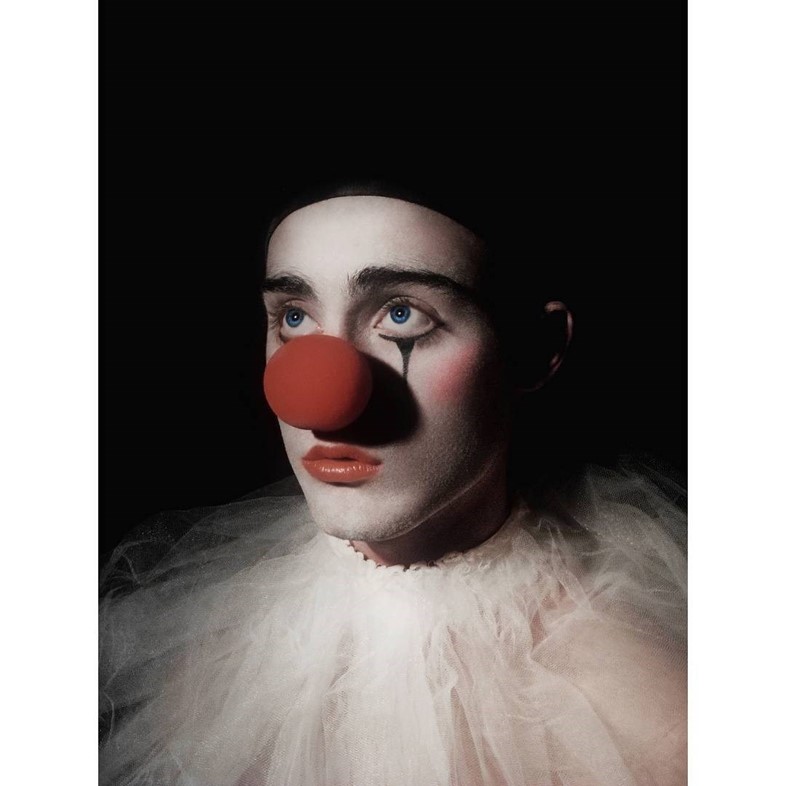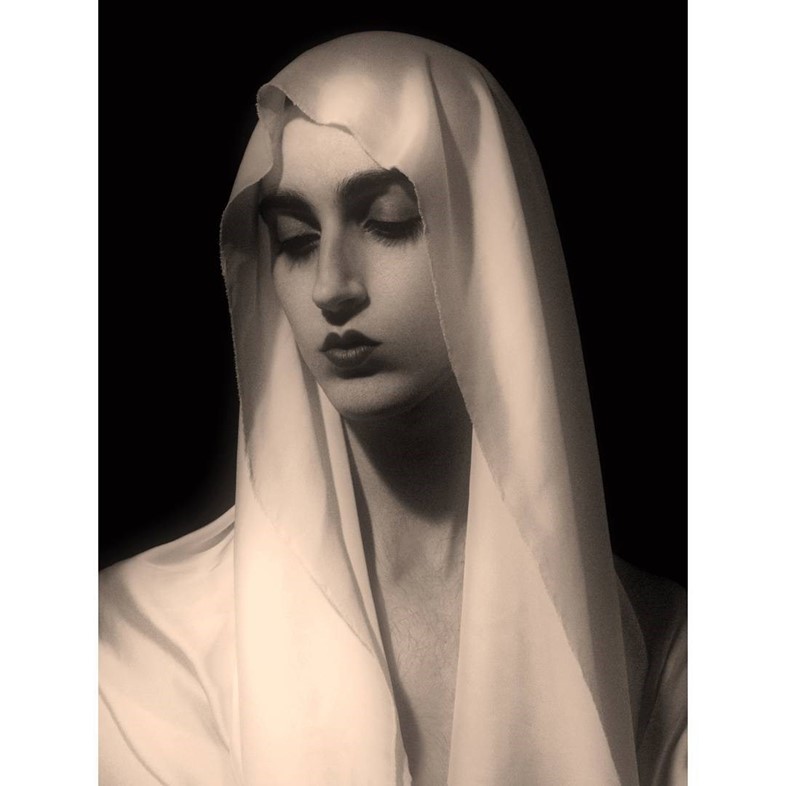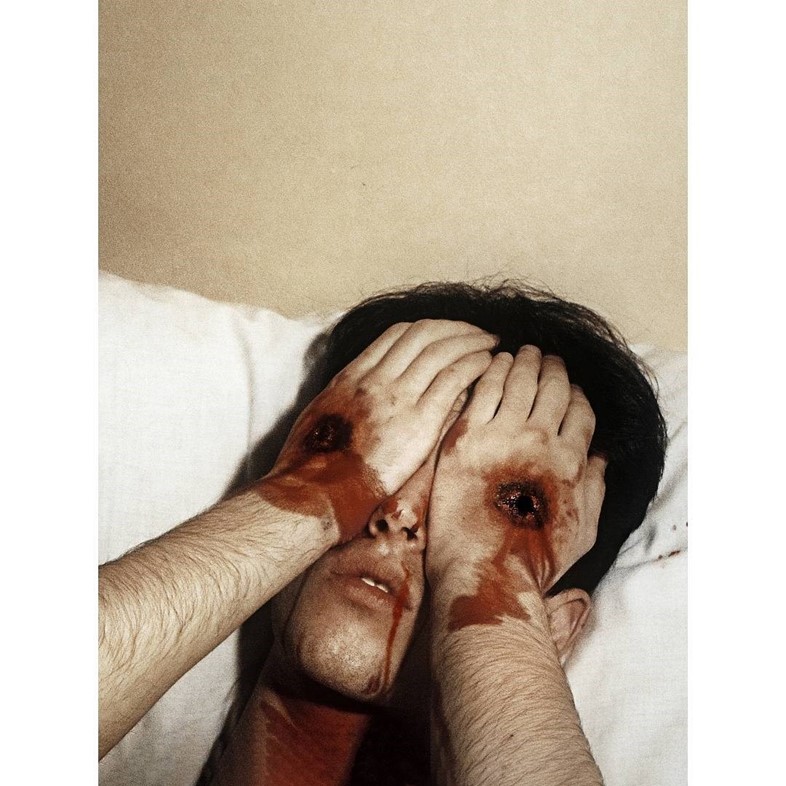- X
- Tumblr
Whether he's fashioning himself into monstrous sea creatures or transforming himself into a tortured angel, Chris Smith's bedroom portraits are pure fantasy. 22-year-old South African artist Chris Smith takes photographs of himself in his bedroom and posts them on Instagram. If that sounds like something you’ve seen before you’d be grossly mistaken.
Chris is his own model, a human chameleon transforming himself across age, gender, time and space. He’s a boxer, a tortured angel, a flapper. Next, he’s a punk, a new romantic, a hippie, a hair rocker. In another breath, he’s a public schoolboy, a miner, a bride. In Chris’s work, identity is always shifting, mercurial and effervescent. “I don’t want my pictures to reflect my reality at all,” he says, “I want them to reflect these fantasies I have.”
Too shy to ask others to pose for him, Chris turned to self-portraits when he was a teenager and was riveted by the whole experience. It was an outlet for his creativity and passion, a way to reimagine and express himself in ways he couldn’t yet in real life, and a way to deal with his sexuality. Since those early days, Chris has continued to transform himself into anyone and anything, and recently collaborated with AnOther Man on a series of striking and electrifying images. Here he talks to us about taking inspiration from cult horror movies, finding beauty in the unusual, and his dream project.

Do you remember the first time you were conscious of your appearance?
Chris Smith: Probably when I was in 3rd grade at school. I was always conscious of the way I carried myself, whether it was the way I dressed, walked, stood and talked, because some of the other children were quick to point out my effeminate traits. I always knew I was different in some way and by the time I was 12, I realised I was gay. It wasn’t until I was 21 that I came out to my family and friends, though, and up until that time I was basically asexual. At school, I also became very self-conscious of how skinny and pale I was. ‘Anorexic’ and ‘drug addict’ were some of the ways people jokingly referred to my appearance when I was younger, which obviously hurt my feelings but I tried not to show it. I never let any of this affect me to the point where I wanted to change things about myself, but even today, l never want to draw attention to my appearance and I’m still not great at taking compliments about the way I look.
Growing up, what informed your understanding of beauty and the way you presented yourself visually?
Chris Smith: I loved Power Rangers and Jurassic Park when I was little. Star Wars is also a big part of my life, I loved it when I was a child and I still love it today (well, the original trilogy and prequels at least). I love horror movies too, I was obsessed with most of the Halloween movies and also the Scream trilogy and The Texas Chainsaw Massacre. I liked the fantasy of movies and all their imagined worlds and scenarios and I was very interested in how they were created, I think I bought nearly every single Star Wars behind the scenes book when I was younger. At the same time, I was watching E! True Hollywood Stories every day and red carpet and movie awards shows and I really loved the glamorous, aspirational world that I saw on TV. I remember one E! True Hollywood Story was called The Many Loves of Marilyn Monroe and I was obsessed with it! Later in my teens, I began looking quite seriously at fashion imagery which I think ultimately embodied all that I had loved as a child; glamour, fantasy and illusion. Fashion imagery is really what got me interested in photography. None of this really impacted the way I presented myself personally, because as I said, I never wanted to draw attention to the way I looked, but I think a lot of it planted the seeds for my ideas on what glamour and fantasy could do.
Why are you an artist?
Chris Smith: I’ve always been a visual person and I’ve always wanted to express myself visually. I think that suppressing my sexuality for so long has a lot to do with the need to freely express myself. So when it came to deciding what I wanted to do career-wise after high school, I ended up choosing to study graphic design even though I was in love with photography. I thought studying graphic design would be more valuable to me because it deals a lot with visual culture and the power of imagery in a broad sense. The problem was that graphic design as a job doesn’t allow for as much free expression as I really needed. Photography always fulfilled that need for me.

© Christopher Smith
Where did you hone your craft?
Chris Smith: I began taking pictures of myself on my cell phone when I was about 15. I used to put sheets up as backdrops and I borrowed clothes from my grandmother and my mother and used to dress up and pose. Eventually, I needed a better camera and I got one when I was 17, which I still use today. Really, I just wanted to learn how to use the camera and I kept taking pictures of myself as a means of learning while finding out about light and composition and overall technique. Because I was unfamiliar with the medium, I was too shy to ask other people to pose for me and that’s really the main reason that I was doing images of myself. I never thought of them as ‘self-portraits’ at that time, they were all just my own private experiments. I did enjoy seeing myself in the images though, it was like looking at a much freer and expressive me than I was at the time.
Tell us a bit about your creative process. From initial idea to final image.
Chris Smith: I’m always looking at images all over the place, especially on TV (which I love), and from books, movies, music videos and things and sometimes I may see something when I’m out at a shop, maybe a wig or a piece of fabric or something that sparks an idea. Then I start building the image in my head, thinking about the type of light and its direction (I use either the light from my window or a reading light I have), the make-up, the hair, the expression and pose, the background and the colours in the image. Nothing is left to chance, I plan the whole thing beforehand. I do all the pictures in my bedroom so I am a little restricted technically, which I like because it forces me to think even harder about things. And then I actually do it. I set up everything to try and match the idea that I imagined in my head. I usually know exactly when I have the image I want.
Is beauty something you try to capture in your work or something that you reject?
Chris Smith: Yes, beauty is very important to me in my work. Personally, I respond most to images of a certain aspirational glamour, an admiration which I think comes through in some of my work. I love images of men and women with some attitude and elegance, that is very beautiful to me. This kind of beauty is different from my own life, which is quite dull and I think that’s why I really like seeing it. But to me, beauty doesn’t necessarily have to come from glamour or dressing up. I mean some of the subjects I deal with are not always beautiful (like death and violence), but then I try to make the image technically beautiful at least, maybe through the use of light and shadow or the composition. For me, I think the image as a whole should be technically beautiful, regardless of the subject matter because I want people to be able to look at them.

© Christopher Smith
In your work you are a human chameleon, what is it about transforming yourself into another that appeals?
Chris Smith: I like to see myself in a way that is so far removed from who I really am, and I like showing the artificiality and ephemeral nature of appearance. Beyond that, I really like creating mini-illusions in the same way that a set designer or movie director does. I love that photography allows me to create little fantasies in my own bedroom from nothing, that’s the real magic of it, making something out of nothing.
Do you still feel like yourself in all your different guises, or do you take on the identity of the character you are performing?
Chris Smith: I don’t feel like myself at all and I don’t even recognise the person in my images to be honest. It’s the hair and make-up and clothes that really help me to take on a different sort of ‘persona’ each time I do a picture. The ‘real’ me is not as interesting to look at as the me in my images and I don’t have the same attitude or confidence and I also really hate having my picture taken.
How do you think our understanding of beauty has shifted with the evolution of technology?
Chris Smith: I think we have so much more access to images and people who both affirm and challenge our own notions of beauty, which is really important for opening minds. I think it’s good that the limits and boundaries of beauty that have existed for years in traditional media have been challenged and eroded through the democratisation of images on the internet. The downside is that many people now look to the artificially relatable and accessible images of beautiful people on social media as standards for beauty, which can be even more damaging as images in traditional media have been for decades. So, I think technology has brought a lot of positive and negative changes that we’re all grappling with at the moment.

© Christopher Smith
What advice would you give to young artists hoping to get into photography as you have?
Chris Smith: I don’t think I’m the best person to give advice to anyone at the moment, but one thing I would say is that it’s best to get to know yourself personally and creatively on your own before you show anyone else your work. I think the desire for instant gratification and affirmation that people expect and get today on social media really ends up killing a lot of creative ambition and exploration. I had been taking pictures (many of them mediocre) for nearly seven years completely on my own before I felt confident enough to share what I was doing on Instagram. And even now, I’m still learning new things about myself and my work every day.
Who would you like to shine a spotlight on next?
Chris Smith: The always-brilliant genius, Julien d’Ys!

